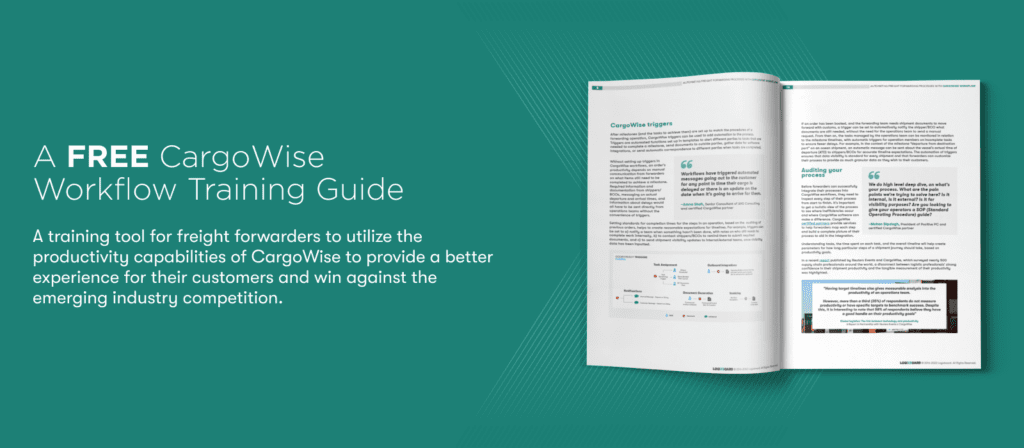With ongoing recruitment and retention challenges in logistics, operations teams across the industry are finding themselves overwhelmed as they try to keep up with growing demand. To combat this, many forwarders are turning to digital solutions to reduce their team’s workload.
Building the right tech stack can take the burden off your employees and help your organization operate more efficiently. Let’s talk about three must-have digital tools for your operations team.
1. Visibility and aggregated data
Between origin, destination, and everything in-between, there’s a lot of information tied to a single shipment. Multiply that by the number of shipments en route at any given time, and your operations team can feel like they’re drowning in data.
In addition to potentially inducing clutter-related stress, disorganized data can also pose a direct cost to employees every time they run into a roadblock or need to find the answer to a question. According to a report by McKinsey, the average customer-facing employee spends nearly 20% of their workweek looking for internal information or tracking down colleagues who can help with specific tasks. By finding a solution to consolidate that data, you can free up that time so your team can focus on more complex projects.
When searching for a platform that fits your needs, try to prioritize a few key features:
- Real-time visibility
- Built-in analytics
- Centralized communication
Real-time visibility
Although a relatively recent innovation, shipment visibility has become increasingly mainstream over the years. As delivery and rideshare apps have popularized real-time tracking at the consumer level, it’s become an expectation across every stage of the supply chain.
In freight forwarding, visibility means more than simply seeing your freight’s location on a map. True real-time visibility requires a comprehensive view of your shipment status, history, and relevant details. By providing a single interface for your operations team to see their shipment information, you’ll make their jobs easier and reduce friction in their day-to-day work.
Find out more about the relationship between tech and customer satisfaction in the FreightWaves study: The Power of Customer Experience in Freight Forwarding.
2. Document management
To this day, physical documents are far too common in the shipping process. However, going paperless is becoming a requirement for competing in today’s industry– especially in the wake of the pandemic’s remote transformation.
With digital document sharing, you can ensure constant access to your files, allowing you to edit or send a record from anywhere. This ease of use can ensure that your documents make it to the right place at the right time, reducing delays and demurrage fees.
However, digital document handling is only the tip of the iceberg. A single international shipment can involve between 9 and 18 documents on average. On top of that, each document typically has its own requirements, stakeholders, and due dates. Even when you’re leveraging digital solutions like email and cloud technology, that volume of information can easily get overwhelming. That’s why it’s crucial to adopt an organized process for managing your files.
With a document management system, you can upload and download shipment documents in a centralized database. By establishing a single source of truth, you’ll be able to eliminate back and forth communication and establish certainty that you’re working with the most up-to-date version of every document.
Built-in analytics
As a freight forwarder, you’re probably accustomed to handling large amounts of data. So, you know it can be difficult to leverage it to its full potential, especially when your data management isn’t up to scratch. Fortunately, many tech solutions offer a built-in analytics feature, allowing users to quickly and easily make sense of their data.
With the right analytics tool, operations teams can see trends, collect business insights, and identify underlying factors in delays and mistakes. Not only can this help inform decisions for the company, but it can also help them relay valuable information to the customer service team with minimal effort.
Centralized communication
For many forwarders, communication throughout the shipment process is disorganized and disjointed. The need for constant coordination with customers, carriers, and internal stakeholders can make it difficult to establish a central communication platform. More often than not, a forwarder’s correspondence is spread across emails, phone calls, faxes, internal system messaging, and more.
This disjointed approach can make it difficult for your team to track down the information they need in a timely manner, leading to frustration and missed messages. By adopting a solution with a user-friendly communication platform, you can keep all of your correspondence in one place.
3. Automation
Relying on manual processes is a common pitfall for freight forwarders. From entering data to sending status updates, many businesses lean solely on human labor to keep their organization running.
Continuing with what works may seem like a good idea in the short term. However, investing resources into enacting the more efficient measures will save time in the long run and put you ahead of the competition. A study by Smartsheet found that 40% of workers spend at least a quarter of their work week on manual tasks. By enabling your operations team to automate repetitive tasks, you’ll free up resources to get ahead in other areas.

In addition to saving time, automation can also improve your organization in other ways, including:
- Increasing employee productivity
- Raising engagement
- Reducing human error
- Improving work quality
Once you’re ready to help your operations team make the shift toward automation, there are a couple of places you can begin.
First, you can start by looking into the tasks that your employees spend most of their time on. Then, try to figure out if there’s a way to automate any of them with tech.
For instance, let’s say your team reports that they’re spending hours per day updating and exporting data. You can take a look at what they’re working on and find out if there are any commonalities or overarching patterns in their tasks. From there, you can talk to your IT team to see if you can build a template, script, or integration to streamline the process.
Another way to begin your journey into automation is by evaluating your tech stack to look for any untapped features you could be leveraging. Even among organizations with digital solutions, many aren’t using their resources to their full capacity.
Look into your current or prospective tech solutions to see if there are any opportunities for optimization. Again, you may have to consult your IT team or service provider to figure out the full extent of the software’s capabilities. Once you’ve found a feature to leverage, you can work with your team to integrate it into their regular process.
Final thoughts
Digital solutions are becoming increasingly central to logistics, even beyond operations. The industry is seeing startups and digital freight forwarders pulling ahead, largely due to their ability to pivot quickly. However, traditional freight forwarders can bridge the gap by undergoing their own digital transformation.
Ready for the ultimate tech solution to streamline your team’s operations? Logixboard connects with your TMS to enhance your processes, with features like real-time visibility, centralized communication, document management, analytics, and more.





